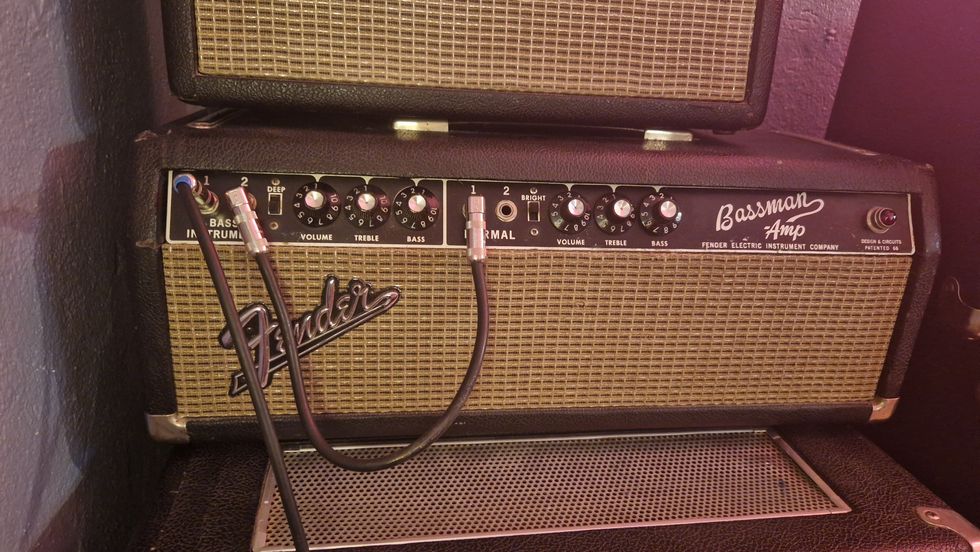
Those of you who have read my earlier columns know I am a diehard fan of the classic Fender tube amps, particularly the black- and silver-panel-era Fenders. They’re great tone platforms that can take you in many directions with various guitars and pedals, and they work just as well for harmonica, electric piano, and bass guitar due to their natural, straightforward tone. In this column, I’ll share my experiences and tips for running a bass through different Fender guitar amps.
Guitar amps and speaker cabinets are normally built much lighter than typical closed bass-amp cabinets. High-wattage bass amps require dense, robust construction that can handle serious air pressure. They’re often closed cabinets with air intakes called bass reflex systems, which control airflow from the speaker vibration and enhance the lower frequencies. But even without a bass reflex system, some guitar amps can produce a nice bass-guitar tone. Obviously, they’re not capable of doing what an 8×10 Ampeg cabinet can do, but for me, that’s not relevant. The music that I listen to and play (mostly ’60s and ’70s rock, soul, and blues) has a laid-back yet articulate bass tone.
I grew up listening to a lot of Donald “Duck” Dunn’s Jazz and Precision bass-guitar playing on recordings by Otis Redding, Booker T. & the M.G.’s, and other legendary artists from Stax records in the ’60s. For Dunn’s tone—which drives the groove and forms a significant part of the mix—you don’t need an extremely deep or punchy bass. With classic Fender guitar amps, you can get a mellow bass tone with medium-low frequencies that blend in smoothly with a band.
Fittingly, the first amp I’d like to mention is the Fender Bassman. The black-panel version—a 50-watt head with a diode rectifier, negative feedback loop, and dual 6L6 tubes—shouts “clean headroom.” The 2×12 speakers in the matching, closed piggy-back cabinet sound bassy and tight, and offer more low end than any of the open-back Fender amps. The amp has two channels, one voiced for bass and one for guitar. The bass channel offers a deep switch to better tune in or out the lowest frequencies, and you can unlock more tone options by installing a 25k mid switch in the normal channel, a mod I explain in my May 2023 column, “Why Did I Ever Sell These Amps?” The mid switch acts like a fat boost that can trigger the amp to distort if you play at the threshold of the amp’s breakup point.
“With classic Fender guitar amps, you can get a mellow bass tone with medium-low frequencies that blend in smoothly with a band.”
Another trick I like to do is jump channels. I dial in a full, relaxed tone on the bass channel, and a brighter tone on the normal channel with the bright switch on. (Sometimes I add some overdriven tones using the mid switch and volume on the normal channel.) If you’re after more volume, consider installing louder, more efficient speakers. The original Oxford, Jensen, or Utah speakers in vintage Fender amps are modest compared to modern ceramic or Neodymium speakers, which can help lighten the heavy speaker cabinet. Plus, you can use other external speaker cabinets with the 4-ohm Bassman head for more punch and different tones. The speaker impedance should be between 2 and 8 ohms, but 4 ohms will give you the most clean headroom.
The Fender Showman and Dual Showman are two other piggy-back amps worth mentioning. Compared to the Bassman, these models have some advantages. They boast almost twice the power for bigger stages and rooms, and the Dual Showman’s flexible impedance allows you to use a variety of speaker cabinets. (I prefer 10″ and 12″ speakers over the original 15″ Showman ones for their faster response and lighter weight.) That said, they lack the Bassman’s deep switch, dedicated bass channel, and ability to jump channels.
Finally, we have the Tweed Bassman and the Super Reverb. By specs alone, the black-panel Super Reverb is the heir of the narrow-panel Tweed Bassman. Both have open-back 4×10 cabinets and a 40-watt, dual 6L6 power amp section in push/pull configuration. With four 10″ speakers working together, the cabinet doesn’t necessarily need to be enclosed to achieve a nice bass tone. These amps will work well for bass guitar in practice and in smaller settings, but be careful with older 10″ speakers. The dry, porous paper speaker cone and thin copper wires can easily be damaged at higher volumes, so for bass usage, I’d recommend replacing them with newer speakers. Since I use my amps for both guitar and bass, I like regular guitar-voiced speakers, but if you’re using the amp exclusively for bass, you might consider using bass-specific speakers.
From Your Site Articles
Related Articles Around the Web









